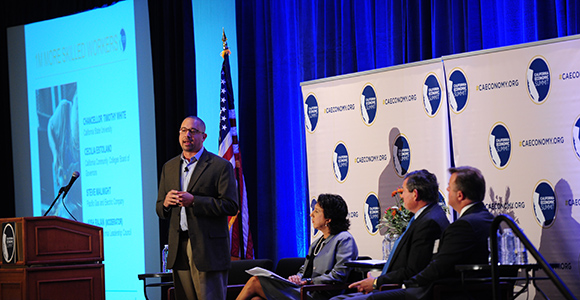
Kish Rajan, president of the Southern California Leadership Council leads the workforce expert conversation on day two of the 2015 California Economic Summit in Ontario, California (Photo Credit: Violeta Vaqueiro)
As California’s economy grows, so does the need for high-skilled and middle-skilled workers. That’s why participants at the 2015 California Economic Summit in Ontario this week worked on an action plan to create pathways for one million more skilled workers in the next decade to restore upward mobility and meet the needs of employers.
Co-presented by California Forward and the California Stewardship Network, the Summit brought together civic and business leaders from across the state to discuss how to move California along the path to prosperity.
In the morning session, Summit participants gathered to discuss how to tackle the challenge, they heard from experts in a morning conversation moderated by Kish Rajan of the Southern California Leadership Council and included California State University Chancellor Timothy White, California Community Colleges Board of Governors member Cecilia Estolano and Steve Malnight of Pacific Gas and Electric.
According to White, “California is suffering through two droughts, one is the one we know of, the other is a drought in bachelor’s degrees,” which, he says, is negatively affecting the state’s economy. A recent Public Policy Institute of California report showed that California will face a shortfall of 1.1 million college graduates by 2030. To put that in perspective, today’s kindergartners and first graders are the class of 2030. White said that the state is funding K-12 education and encouraging students to get their bachelor’s degree, but funding for CSU and UC are falling short, which will eventually create a bottleneck as more students try to get into college.
To Estolano, using data will become an increasingly important part of preparing institutions to better align with the changing nature of business. This is especially important with career technical education as business and technology are changing at a face pace. Estolano also brought up the 25 recommendations from the California Community Colleges Task Force will be presented to the Board of Governors of Monday, November 16.
The Summit participated on the California Community Colleges Task Force on Workforce, Job Creation, and a Strong Economy, which was partly inspired by the Summit repeatedly identifying workforce and skills issues as big problems in all regions of the state.
On the industry side, Malnight said public-private partnerships are critical to advise students about the career for which they are preparing: “Industry can play a vital role in having students know what’s on the other side.”
In the interactive session to discuss how they will tackle the challenge, Summit participants discussed priorities for the next years which include:
- Create a regional civic structure
Support the formation of regional civic organizations dedicated to accelerating the implementation of the California Community Colleges Task Force recommendations.
- Align around data metrics
Identify and align data and metrics to assess workforce requirements and needed skills
- Create promoting centers
Develop and advocate for incentives that improve programs and job placements
- Connect industry and institutions
Expose students to business and business to students
- Develop infrastructure to connect workers and jobs
Promote infrastructure such as housing and broadband that supports entrepreneurs, grows jobs and brings workers and jobs closer together while holding local governments accountable for making it happen.
Now it is the job of Summit participants who have engaged and committed to the priorities to return to their regions and work with local stakeholders to create one million more skilled workers in the next decade.

